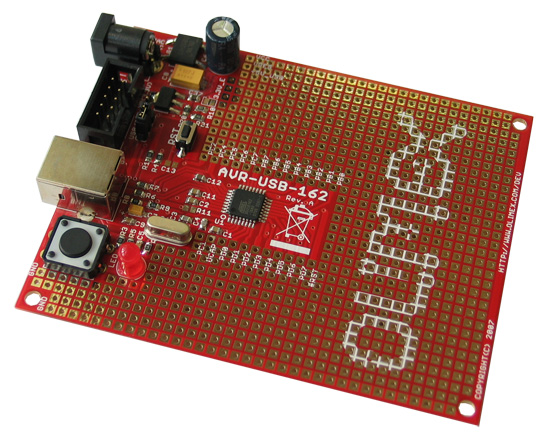This was another development board that I purchased a long time ago, its a board for the AT90USB162 from Olimex and its a good, solid option
Specs
Lets look at the specs of the AT90USB162
The microcontroller combines 16KB ISP flash memory with read-while-write capabilities, 512B EEPROM, 512 bytes SRAM, 22 general purpose I/O lines, 32 general purpose working registers, two flexible timer/counters with compare modes and PWM, USART, programmable watchdog timer with internal oscillator, SPI serial port, debugWIRE interface for on-chip debugging and programming, and five software selectable power saving modes.
The device operates between 2.7-5.5 volts.
| Program Memory Type | Flash |
| Program Memory Size (KB) | 16 |
| CPU Speed (MIPS/DMIPS) | 16 |
| Data EEPROM (bytes) | 512 |
| Capture/Compare/PWM (CCP) | 1 |
| Max 8 Bit Digital Timers | 0 |
| Number of ADCs | 0 |
| ADC Channels | 0 |
| Max ADC Resolution (bits) | 0 |
| Number of Comparators | 1 |
| Temp. Range Min. | -40 |
| Temp. Range Max. | 85 |
| Operation Voltage Max.(V) | 5.5 |
| Operation Voltage Min.(V) | 2.7 |
| Pin Count | 32 |
| Low Power | No |
Now lets add in the AVR-USB-162 development board from Olimex
You have the microcontroller above and you also get the following on the board
- ICSP 5×2 pin connector for in-circuit programming with AVR-ISP-MK2 (you generally don’t need to use ICSP as you can program via USB)
- Debug Wire could be performed by 3 wires connected to ICSP (AT-JTAGICE-MK2 have such lose wire connector which to be used, you need VCC, GND, RST signals only)
- USB 2.0 connection
- User button BUT (can be used to enter bootloader mode after reset)
- Reset button RST
- Takes power from USB so there is no need for external adapter
- You can use an external power supply and voltage regulator if USB can’t provide enough power. I always recommend this option to be honest.
- Quartz crystal oscillator circuit 8Mhz
- Extension pin headers for each uC pin
Summary
A decent development board for a fairly capable microcontroller. When you factor in that the cost of the board is only 8 Euros its a very good price. The board is good quality and there is a substantial prototyping area, if you need it.
The board will work with Microchip (used to be Atmel) Studio and you do not need to buy an external programmer, if you need a debugger thats a different story but this is quite often the case anyway
Olimex supplies a couple of examples, as you can see in the links below, these are fairly standard examples but at least you are not on your own.
Using this a mouse, keyboard seems to be a fairly interesting use case

